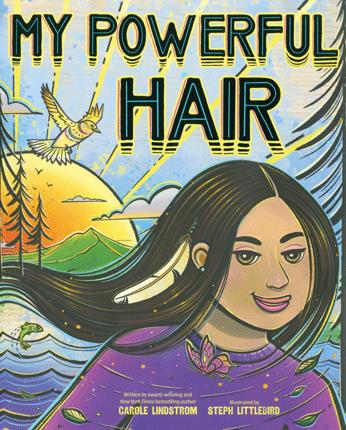| My powerful hair Author: Lindstrom, Carole | ||
| Price: $23.78 | ||
Summary:
After generations of short hair in her family, a little girl celebrates growing her hair long to connect to her culture and honor the strength and resilience of those who came before her.
| Illustrator: | Littlebird, Steph |
| Accelerated Reader Information: Interest Level: LG Reading Level: 3.50 Points: .5 Quiz: 520356 |
Reviews:
Kirkus Reviews (+) (05/15/23)
School Library Journal (+) (02/24/23)
Booklist (+) (12/01/23)
The Hornbook (+) (00/03/23)
Full Text Reviews:
School Library Journal - 02/24/2023 K-Gr 4—"I can't wait for my hair to grow" is the powerful opening to this book, which lays groundwork for this compelling story highlighting not only the significance of hair to Indigenous peoples, but also memory, generational trauma, and the power of healing. Using three generations of hair as the medium, Lindstom's sparse, poetic language ("Our ancestors say: Our hair is our memories. Our source of strength") and Littlebird's bright palette capture both serenity and hope. The debut illustrator's watercolor, ink, and computer-generated art resembles woodcuts—an effective medium for the etchings contained within the long, dark hair floating across double spreads. Deep blues, pinks, and purples, punctuated by hopeful yellow, highlight the joy of memory and culture, particularly on spreads that use circles to underscore connection between generations. That only one (muted) spread explicitly references the Indian boarding schools that robbed the narrator's grandmother of her hair highlights the power of healing, though back matter details the schools' cruelty and lasting legacy. VERDICT This is an emotionally searing story infused with important historical and cultural information on the significance of hair to Indigenous cultures. Highly recommended for all library collections.—Rebecca Kirshenbaum - Copyright 2023 Publishers Weekly, Library Journal and/or School Library Journal used with permission.
School Library Journal - 02/24/2023 K-Gr 4—"I can't wait for my hair to grow" is the powerful opening to this book, which lays groundwork for this compelling story highlighting not only the significance of hair to Indigenous peoples, but also memory, generational trauma, and the power of healing. Using three generations of hair as the medium, Lindstom's sparse, poetic language ("Our ancestors say: Our hair is our memories. Our source of strength") and Littlebird's bright palette capture both serenity and hope. The debut illustrator's watercolor, ink, and computer-generated art resembles woodcuts—an effective medium for the etchings contained within the long, dark hair floating across double spreads. Deep blues, pinks, and purples, punctuated by hopeful yellow, highlight the joy of memory and culture, particularly on spreads that use circles to underscore connection between generations. That only one (muted) spread explicitly references the Indian boarding schools that robbed the narrator's grandmother of her hair highlights the power of healing, though back matter details the schools' cruelty and lasting legacy. VERDICT This is an emotionally searing story infused with important historical and cultural information on the significance of hair to Indigenous cultures. Highly recommended for all library collections.—Rebecca Kirshenbaum - Copyright 2023 Publishers Weekly, Library Journal and/or School Library Journal used with permission.
Booklist - 03/15/2023 *Starred Review* Caldecott author Lindstrom (Turtle Mountain Ojibwe) here celebrates the importance of hair to Indigenous cultures. Although her mother and grandmother have chosen to keep their hair short, this young protagonist cannot wait for her hair to grow long. She connects specific memories to her hair length: touching her ears when Nimishoomis (Grandfather) teaches her to fish; shoulder length when her brother is born; past her shoulders when she learns to make moccasins; and the middle of her back when she dances at Pow Wow. She shares traditional knowledge articulating that hair contains stories and memories, gives strength, and celebrates relationships. Noting the custom of cutting hair when a loved one dies, she further posits that hair is a living scrapbook. Littlebird’s (Oregon Tribes of the Grand Ronde) pencil-and-digital art features simple shapes, flowing lines, and a palette of purples, turquoise, and greens, accented in yellow. With backgrounds suggesting wood grain and thickly outlined shapes throughout, the illustrations evoke woodcuts and give the presentation a timeless feel. Appended with an author’s note that poignantly explains why haircutting at Indian residential schools was so traumatic, this makes a thoughtful and enlightening addition to the picture book shelves and a worthy choice for units on Indigenous cultures. - Copyright 2023 Booklist.
School Library Journal - 02/24/2023 K-Gr 4—"I can't wait for my hair to grow" is the powerful opening to this book, which lays groundwork for this compelling story highlighting not only the significance of hair to Indigenous peoples, but also memory, generational trauma, and the power of healing. Using three generations of hair as the medium, Lindstom's sparse, poetic language ("Our ancestors say: Our hair is our memories. Our source of strength") and Littlebird's bright palette capture both serenity and hope. The debut illustrator's watercolor, ink, and computer-generated art resembles woodcuts—an effective medium for the etchings contained within the long, dark hair floating across double spreads. Deep blues, pinks, and purples, punctuated by hopeful yellow, highlight the joy of memory and culture, particularly on spreads that use circles to underscore connection between generations. That only one (muted) spread explicitly references the Indian boarding schools that robbed the narrator's grandmother of her hair highlights the power of healing, though back matter details the schools' cruelty and lasting legacy. VERDICT This is an emotionally searing story infused with important historical and cultural information on the significance of hair to Indigenous cultures. Highly recommended for all library collections.—Rebecca Kirshenbaum - Copyright 2023 Publishers Weekly, Library Journal and/or School Library Journal used with permission.



